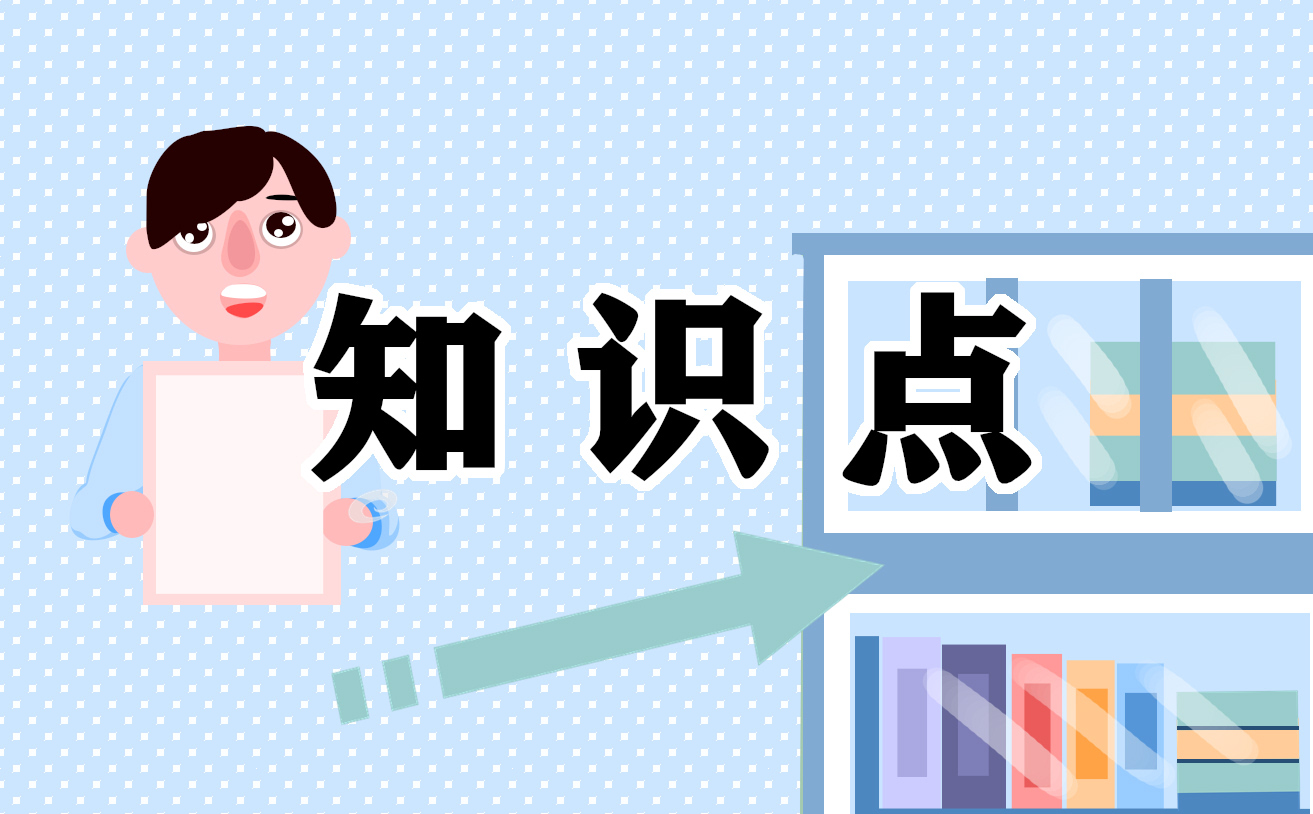英语初中考点总结
初中英语主要是对英语词汇的形式和句型的形式进行学习,初中学生可以加强英语词汇的记忆和主要考点句型的了解,这样对英语成绩的提升会有所帮助。今天小编在这给大家整理了一些英语初中考点总结,我们一起来看看吧!

英语初中考点总结
考点1:forget的用法
a.区分:forget to do something和foeget doing something。
forget to do sth 忘记要去做某事。例如:Sorry,I forgot to bring the book.
forget doing sth 忘记以前曾经做过某事。例如:I forgot borrowing a book from you.
区分:forget与leave
forget侧重于忘记了人,事,物;leave侧重于留下,落下了信息,具体东西。
拓展:可以常考forget的用法来区分remember to do something和remember doing something的用法。
考点2:enough的用法
a.enough +名词/名词+enough;adj/adv+enough.
b.too...to...与...enough to及so...that进行句型转换。
c.注意字母ou与gh的发音。
考点3:ready的用法
a.be ready to do something 准备去做某事 ;be ready for something 为某事做准备
同意短语:be prepared to/for.
考点4:“借”的用法
borrow “借入”,常用结构:borrow something from somebody.
lend “借出”,常用lend something to somebody或lend somebody something的结构。
keep为borrow的延续性动词。意为“保留”,后常跟for+一段时间。
考点5:五个“穿”用法
wear“穿着;戴着”,表示状态,宾语可以是衣帽,也可以是饰物、奖章等。例如:He is wearing blue pants .他穿着蓝色的裤子。
put on“穿上、戴上”,强调“穿”“戴”的动作,后接衣服、鞋帽等。例如:Put on your heavy winter coat ,or you will catch a cold.
be in 后接表示衣服或颜色的词,着重于服装的款式或颜色。例如:This is a picture of a young man in a black coat.
have on的意思是“穿着,戴着”,例如:She will have on black pants and a gray shirt tomorrow.明天她会穿一条黑色的长裤和一件灰色的衬衫。
dress的宾语通常是人,意思是“给……穿衣服”。另外,be dressed in 的意思是“穿着”,表示状态;dress up的意思是“盛装打扮、乔装打扮”;get dressed意为“穿衣”。
考点6:四个“看”
look意为“看”,为不及物动词,不跟宾语。若跟宾语,则用 look at.
read意为“读”,后跟杂志,报纸,书籍等。
watch= look at sb./ sth. carefully"仔细观看,注视"。后常跟比赛,电影等。
see意为“看见”,表结果。
notice有"注意到,提醒别人注意"等意思,汉语中常有"通知、启示、告示"之意。
考点7:区分:too much,too many,much too
too much:意思是“太多的...”,用于修饰不可数名词,如;too much water,too much time等。
too many:意思也是“太多的...”,用于修饰可数名词复数,如too many pens,too many books等。
much too:意思是“非常,太”,用于修饰形容词或副词,如much too big,much too long等。
重要结构:
what/how about用于反问:what about you?;也可以用于征求意见:What about go shopping?
had better+动词原形。
怎么了:What's the matter with you?=What's wrong with you?=What's the trouble with you?=What happed to you?,口语还可以用What's up?
到...什么时间了:it is time to...;it is time for...
Would you like...?
问价格的两种表达:How much...?;What's the price of...?
be的用法
人称代词和物主代词
have的用法
名词的复数形式
可数名词与不可数名词
一般现在时
英语初中考点解析
一般现在时的用法
1) 经常性或习惯性的动作,常与表示频腮度的时间状语连用.
时间状语: every…, sometimes, at…, on Sunday
I leave home for school at 7 every morning.
2) 客观真理,客观存在,科学事实.
The earth moves around the sun.
Shanghai lies in the east of China.
3) 表示格言或警句中.
Pride goes before a fall. 骄者必败.
注意:此用法如果出现在宾语从句中,即使主句是过去时,从句谓语也要用一般现在时.
例:Columbus proved that the earth is round..
4) 现在时刻的状态、能力、性格、个性.
I don’t want so much.
Ann Wang writes good English but does not speak well.
比较:Now I put the sugar in the cup.
I am doing my homework now.
第一句用一般现在时,用于操作演示或指导说明的示范性动作,表示言行的瞬间动作.再如:Now watch me, I switch on the current and stand back. 第二句中的now是进行时的标志,表示正在进行的动作的客观状况,所以后句用一般现在时.
2. 一般过去时的用法
1)在确定的过去时间里所发生的动作或存在的状态.
时间状语有:yesterday, last week, an hour ago, the other day, in 1982等.
Where did you go just now?
2)表示在过去一段时间内,经常性或习惯性的动作.
When I was a child, I often played football in the street.
Whenever the Browns went during their visit, they were given a warm welcome.
3)句型:
It is time for sb. to do sth "到……时间了" "该……了"
It is time sb. did sth. "时间已迟了" "早该……了"
It is time for you to go to bed. 你该睡觉了.
It is time you went to bed. 你早该睡觉了.
would (had) rather sb. did sth. 表示’宁愿某人做某事’
I’d rather you came tomorrow.
4) wish, wonder, think, hope 等用过去时,作试探性的询问、请求、建议等.
I thought you might have some. 我以为你想要一些.
英语初中考点
一般现在时 do
一般过去时 did
一般将来时 will do
现在进行时 is(am are)doing
过去进行时 was(were)doing
一般过去将来时 would do
过去完成时态 had done
现在完成时 have(has)done
一、 一般现在时
1、定义 表示经常发生的动作或存在的状态,如能力、特征、性质、身份等.
2、构成 1) be --- is, am, are 2) 实意动词用原形表示 (注意当主语为第三人称单数时,动词 + s或 + es)
句型转换 1) 情态动词,联系动词提前或直接在其后加 not 2) 实意动词加do/ does或don't/ doesn't
3、用法 1) 表示经常性的、习惯性的或永久性的动作,常与 always, usually, often, sometimes, every day,
twice a month等连用. e.g. Does he usually go to school on foot?
2) 表示存在的状态,常用动词 be, have, love, like, know, see, hear, think, have, belong to 等.注意这些
动词一般不用被动语态. e.g. He doesn't like music.
3) 表示不受时间限制的客观事实或普遍真理. e.g. The earth goes round the sun.
二、一般过去时
1、定义 表示过去某一时间内发生的动作或存在的状态,可能是一次的,也可能是经常的,动作已完成.
2、构成 1) be – was,were 2) 实意动词用过去式来表示,没有人称和数的变化.
句型转换 1) was, were 提前或直接加 not 2) 实意动词加did或didn't(动词改为原形)
3、用法 1) 表示过去某一时间内发生的动作或存在的状态,常与表示过去的时间状语连用 yesterday , last Friday, in 1994, an hour ago, a moment ago, last November, before 1997, on December 26, 1976. yesterday morning.
2) 表示过去经常或反复发生的动作. When I was in the university, I did morning exercises every day.
3) had(have的过去式)当“有”讲时,构成疑问和否定有两种形式,其他词义同实意动词.
Did you have no friends? He hasn't enough time.
My father doesn't have lunch at factory. (不用 haven't) Did you have a good time?
三、一般将来时
1、定义 表示将来某一时间内要发生的动作或存在的状态,常与表示将来的时间状语连用.如tomorrow, today, this week, next week, next month, next year, next Wednesday, from now on, in a year, in the future
2、构成和用法1)shall (第一人称)和will (所有人称) + 动词原形, 缩写为 “'ll”,否定缩写为shan't, won't.
2) be going to do,常用于口语,表示打算去做的事和可能要发生的事. It's going to rain.
3) is/ am/ are about to do...when...表马上要发生的事,不与时间连用.I was about to leave when it rained.
4) be to do sth. 按计划或职责、义务要求必须做的事或即将发生的动作.
5) 终止性动词come, go, leave, arrive等的现在进行时刻表示按计划,安排或即将进行的动作.
6) 以if, as soon as, when, once, unless等引导的从句的一般现在时表示一般将来时.
四、过去将来时
1、定义 表示从过去某一时间来看将要发生的动作或存在的状态.
2、构成及用法 should (第一人称)或would (第二,三人称) + 动词原形,常用于宾语从句中.
We asked him where we should have a meeting. 其他用法见一般将来时.
